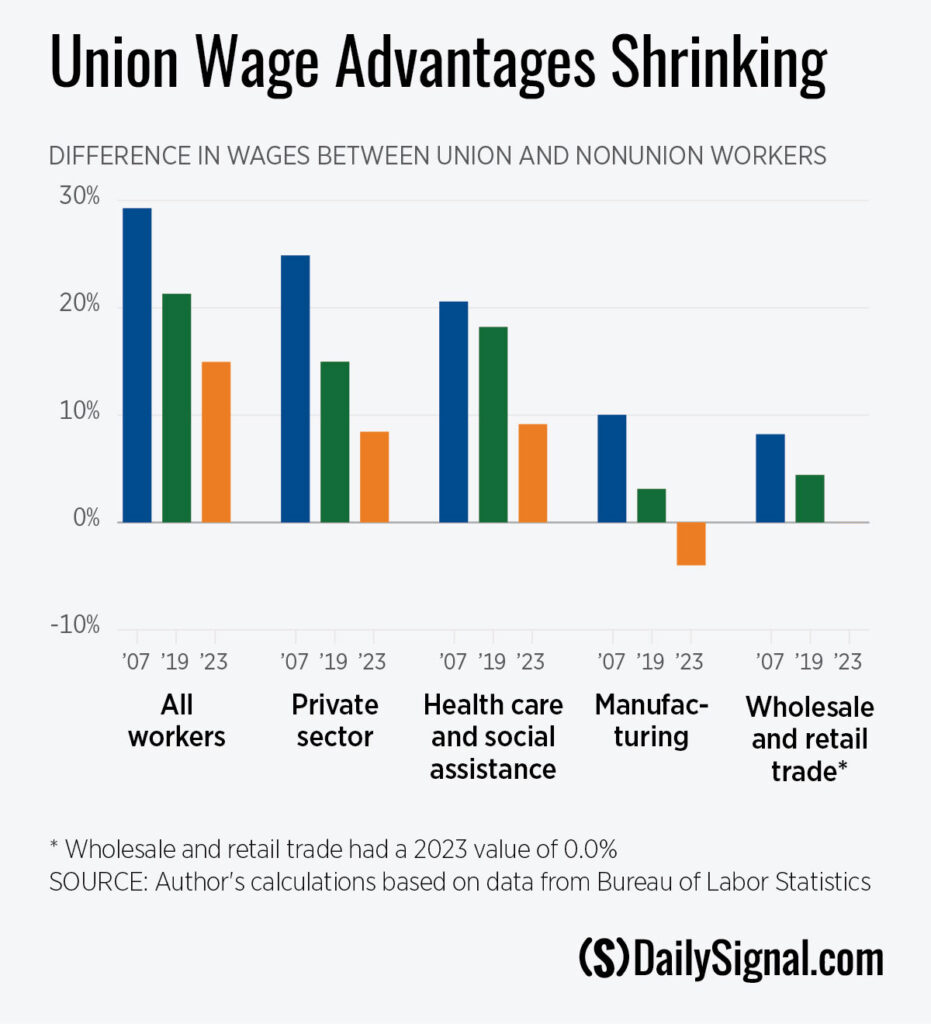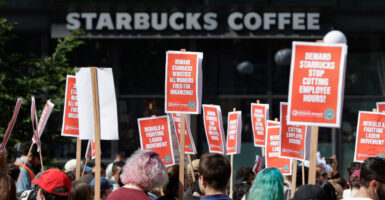The percentage of workers who belong to unions in the U.S. notched down to a record-low 10.0% in 2023, from 10.1% in 2022.
The peak for unionization in the U.S. was about 35% in the mid-1950s.
Even more noteworthy is the shrinking gap between union and nonunion wages, which fell to a record-low of 15.0% in 2023. That’s roughly half the peak of 29.3% as recently as 2007.
Among private sector workers, the decline is wage differences is even more stark. The gap between union and nonunion wages fell by two-thirds between 2007 and 2023, from 24.9% to 8.4%.
Historically, union wages have been significantly higher than nonunion wages. That’s because unions function like cartels to drive up wages for the workers they represent, which restricts the number of workers companies can employ and creates upward pressure on company prices.
Selection bias, such a union’s seniority-based pay scales and “last-hired, first-fired” layoff rules, can also elevate union wages above nonunion wages.
Until recently, the wage differential between union and nonunion workers in the U.S. was around 25%. That gap has plummeted in recent years as nonunion workers’ wages have grown faster than those of union workers. Between 2019 and 2023, nonunion wages rose 22.2% (before inflation) while union wages rose only 15.8%.
Consequently, the difference between union and nonunion wages fell from 21.3% in 2019 to 15.0% last year.
Unions’ wage advantage has declined across nearly every industry over the past four years, with the exception of the education and leisure & hospitality sectors. In some industries, the decline in union wage advantages has been especially steep.

In health care and social services, the union wage advantage was cut in half from 2019 to 2023, from 18.2% to 9.2%.
In the wholesale and retail trade, the difference between union and nonunion wages disappeared, from 4.4% to 0%.
And in manufacturing, unions’ wage advantage reversed, from 3.1% in 2019 to -4.0% in 2023, with nonunion manufacturing wages now exceeding union pay.
So, why have unionization rates and union wages been falling despite significant union-organizing efforts at places such as Starbucks, Amazon and Trader Joe’s, as well as President Joe Biden’s “whole of government” approach toward increasing unionization?
Primarily, it’s because unions aren’t providing things that workers want or need. Many workers don’t like unions spending their dues on politics instead of representation, their not infrequent deception and coercion to gain support or their rigid structures that impede flexibility and prohibit performance-based pay.
Meanwhile, by engaging directly with their employers, workers have been able to achieve stronger wage gains (albeit entirely erased by inflation), increased workplace flexibility, expanded benefits (such as paid family leave) and a multitude of educational opportunities.
Those direct relationships allow workers to express their unique needs and desires, as opposed to having to go through a union whose singular voice does not necessarily represent their own. And while nonunion workers can approach their boss anytime regarding their compensation or schedule, unions’ contract negotiations are limited to once every three or more years.
The labor market will not stay as strong as it has been in recent years, and a slew of labor market regulations are poised to make it harder for workers to achieve rising wages and flexible work that meets their needs.
That’s why it’s important that policymakers take action to protect workers’ rights and maximize their opportunities.
The Employee Rights Act includes many important protections and much-needed labor law modernizations. And if unions want to attract more workers, they should offer new models of worker organization and use members’ dues on things that workers want.
Have an opinion about this article? To sound off, please email letters@DailySignal.com and we’ll consider publishing your edited remarks in our regular “We Hear You” feature. Remember to include the url or headline of the article plus your name and town and/or state.

























